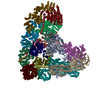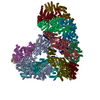[English] 日本語
 Yorodumi
Yorodumi- EMDB-3432: Anaphase-promoting complex/Cyclosome (APC/C)-CDH1-UBE2C (aka UBCH... -
+ Open data
Open data
- Basic information
Basic information
| Entry | Database: EMDB / ID: EMD-3432 | |||||||||
|---|---|---|---|---|---|---|---|---|---|---|
| Title | Anaphase-promoting complex/Cyclosome (APC/C)-CDH1-UBE2C (aka UBCH10)-substrate-Ubiquitin (variant) | |||||||||
 Map data Map data | Anaphase-promoting complex/Cyclosome (APC/C)-CDH1-UBE2C (aka UBCH10)-substrate-Ubiquitin (variant) | |||||||||
 Sample Sample |
| |||||||||
 Keywords Keywords |  Anaphase Promoting Complex / ubiquitin ligation Anaphase Promoting Complex / ubiquitin ligation | |||||||||
| Function / homology |  Function and homology information Function and homology information: / : / Translesion synthesis by REV1 / Recognition of DNA damage by PCNA-containing replication complex / APC/C:Cdc20 mediated degradation of Cyclin B / APC-Cdc20 mediated degradation of Nek2A / Activated NOTCH1 Transmits Signal to the Nucleus / Downregulation of TGF-beta receptor signaling / Regulation of FZD by ubiquitination / Regulation of TNFR1 signaling ...: / : / Translesion synthesis by REV1 / Recognition of DNA damage by PCNA-containing replication complex / APC/C:Cdc20 mediated degradation of Cyclin B / APC-Cdc20 mediated degradation of Nek2A / Activated NOTCH1 Transmits Signal to the Nucleus / Downregulation of TGF-beta receptor signaling / Regulation of FZD by ubiquitination / Regulation of TNFR1 signaling / TNFR1-induced NF-kappa-B signaling pathway / Translesion synthesis by POLK / Translesion synthesis by POLI / Termination of translesion DNA synthesis / Gap-filling DNA repair synthesis and ligation in GG-NER / Formation of TC-NER Pre-Incision Complex / Dual incision in TC-NER / Gap-filling DNA repair synthesis and ligation in TC-NER / Fanconi Anemia Pathway / Regulation of TP53 Degradation / Regulation of TP53 Activity through Methylation / Cyclin D associated events in G1 / Stabilization of p53 / PTK6 Regulates RTKs and Their Effectors AKT1 and DOK1 / Synthesis of active ubiquitin: roles of E1 and E2 enzymes / ER Quality Control Compartment (ERQC) / Endosomal Sorting Complex Required For Transport (ESCRT) / IRAK2 mediated activation of TAK1 complex / TRAF6-mediated induction of TAK1 complex within TLR4 complex / Alpha-protein kinase 1 signaling pathway / Inactivation of CSF3 (G-CSF) signaling / IRAK2 mediated activation of TAK1 complex upon TLR7/8 or 9 stimulation / NOD1/2 Signaling Pathway / activated TAK1 mediates p38 MAPK activation / JNK (c-Jun kinases) phosphorylation and activation mediated by activated human TAK1 / DNA Damage Recognition in GG-NER / Formation of Incision Complex in GG-NER / Dual Incision in GG-NER / E3 ubiquitin ligases ubiquitinate target proteins / Translesion Synthesis by POLH / Downregulation of ERBB2:ERBB3 signaling / TCF dependent signaling in response to WNT / Regulation of innate immune responses to cytosolic DNA / HDR through Homologous Recombination (HRR) / Downregulation of ERBB2 signaling / Regulation of signaling by CBL / : / Recruitment and ATM-mediated phosphorylation of repair and signaling proteins at DNA double strand breaks / NOTCH3 Activation and Transmission of Signal to the Nucleus / protein localization to septin ring / Downregulation of ERBB4 signaling / Stimuli-sensing channels / Deactivation of the beta-catenin transactivating complex / Josephin domain DUBs / Ovarian tumor domain proteases / Negative regulation of MET activity / Interleukin-1 signaling / Regulation of PTEN localization / mitotic morphogenesis checkpoint signaling / Regulation of necroptotic cell death / Pexophagy / N-glycan trimming in the ER and Calnexin/Calreticulin cycle / Metalloprotease DUBs / Aggrephagy / Oxygen-dependent proline hydroxylation of Hypoxia-inducible Factor Alpha / Autodegradation of Cdh1 by Cdh1:APC/C / APC/C:Cdc20 mediated degradation of Securin / APC/C:Cdh1 mediated degradation of Cdc20 and other APC/C:Cdh1 targeted proteins in late mitosis/early G1 / Cdc20:Phospho-APC/C mediated degradation of Cyclin A / SCF(Skp2)-mediated degradation of p27/p21 / NRIF signals cell death from the nucleus / NF-kB is activated and signals survival / TGF-beta receptor signaling in EMT (epithelial to mesenchymal transition) / Autodegradation of the E3 ubiquitin ligase COP1 / Asymmetric localization of PCP proteins / Degradation of DVL / Hedgehog ligand biogenesis / Dectin-1 mediated noncanonical NF-kB signaling / Degradation of GLI1 by the proteasome / Hedgehog 'on' state / TNFR2 non-canonical NF-kB pathway / NIK-->noncanonical NF-kB signaling / UCH proteinases / CDK-mediated phosphorylation and removal of Cdc6 / G2/M Checkpoints / Ubiquitin Mediated Degradation of Phosphorylated Cdc25A / Ubiquitin-dependent degradation of Cyclin D / The role of GTSE1 in G2/M progression after G2 checkpoint / FBXL7 down-regulates AURKA during mitotic entry and in early mitosis / RUNX1 regulates transcription of genes involved in differentiation of HSCs / Regulation of RUNX3 expression and activity / p75NTR recruits signalling complexes / TAK1-dependent IKK and NF-kappa-B activation / GLI3 is processed to GLI3R by the proteasome / Activation of NF-kappaB in B cells / Degradation of beta-catenin by the destruction complex / Degradation of AXIN / Regulation of RAS by GAPs / Orc1 removal from chromatin /  Neddylation NeddylationSimilarity search - Function | |||||||||
| Biological species |   Homo sapiens (human) Homo sapiens (human) | |||||||||
| Method |  single particle reconstruction / single particle reconstruction /  cryo EM / Resolution: 6.4 Å cryo EM / Resolution: 6.4 Å | |||||||||
 Authors Authors | Brown N / VanderLinden R / Watson E / Weissmann F / Ordureau A / Wu K-P / Yu S / Mercedi P / Harrison J / Davidson I ...Brown N / VanderLinden R / Watson E / Weissmann F / Ordureau A / Wu K-P / Yu S / Mercedi P / Harrison J / Davidson I / Coudevylle R / Lu Y / Dube P / Brunner M / Grace CRR / Miller D / Haselbach D / Jarvis M / Yamaguchi M / Yanishevski D / Petzold G / Sidhu S / Kuhlman B / Kirschner M / Harper JW / Peters J-M / Stark H / Schulman BA | |||||||||
 Citation Citation |  Journal: Cell / Year: 2016 Journal: Cell / Year: 2016Title: Dual RING E3 Architectures Regulate Multiubiquitination and Ubiquitin Chain Elongation by APC/C. Authors: Nicholas G Brown / Ryan VanderLinden / Edmond R Watson / Florian Weissmann / Alban Ordureau / Kuen-Phon Wu / Wei Zhang / Shanshan Yu / Peter Y Mercredi / Joseph S Harrison / Iain F Davidson ...Authors: Nicholas G Brown / Ryan VanderLinden / Edmond R Watson / Florian Weissmann / Alban Ordureau / Kuen-Phon Wu / Wei Zhang / Shanshan Yu / Peter Y Mercredi / Joseph S Harrison / Iain F Davidson / Renping Qiao / Ying Lu / Prakash Dube / Michael R Brunner / Christy R R Grace / Darcie J Miller / David Haselbach / Marc A Jarvis / Masaya Yamaguchi / David Yanishevski / Georg Petzold / Sachdev S Sidhu / Brian Kuhlman / Marc W Kirschner / J Wade Harper / Jan-Michael Peters / Holger Stark / Brenda A Schulman /     Abstract: Protein ubiquitination involves E1, E2, and E3 trienzyme cascades. E2 and RING E3 enzymes often collaborate to first prime a substrate with a single ubiquitin (UB) and then achieve different forms of ...Protein ubiquitination involves E1, E2, and E3 trienzyme cascades. E2 and RING E3 enzymes often collaborate to first prime a substrate with a single ubiquitin (UB) and then achieve different forms of polyubiquitination: multiubiquitination of several sites and elongation of linkage-specific UB chains. Here, cryo-EM and biochemistry show that the human E3 anaphase-promoting complex/cyclosome (APC/C) and its two partner E2s, UBE2C (aka UBCH10) and UBE2S, adopt specialized catalytic architectures for these two distinct forms of polyubiquitination. The APC/C RING constrains UBE2C proximal to a substrate and simultaneously binds a substrate-linked UB to drive processive multiubiquitination. Alternatively, during UB chain elongation, the RING does not bind UBE2S but rather lures an evolving substrate-linked UB to UBE2S positioned through a cullin interaction to generate a Lys11-linked chain. Our findings define mechanisms of APC/C regulation, and establish principles by which specialized E3-E2-substrate-UB architectures control different forms of polyubiquitination. | |||||||||
| History |
|
- Structure visualization
Structure visualization
| Movie |
 Movie viewer Movie viewer |
|---|---|
| Structure viewer | EM map:  SurfView SurfView Molmil Molmil Jmol/JSmol Jmol/JSmol |
| Supplemental images |
- Downloads & links
Downloads & links
-EMDB archive
| Map data |  emd_3432.map.gz emd_3432.map.gz | 58.7 MB |  EMDB map data format EMDB map data format | |
|---|---|---|---|---|
| Header (meta data) |  emd-3432-v30.xml emd-3432-v30.xml emd-3432.xml emd-3432.xml | 9.9 KB 9.9 KB | Display Display |  EMDB header EMDB header |
| Images |  image_3432.png image_3432.png | 435.2 KB | ||
| Archive directory |  http://ftp.pdbj.org/pub/emdb/structures/EMD-3432 http://ftp.pdbj.org/pub/emdb/structures/EMD-3432 ftp://ftp.pdbj.org/pub/emdb/structures/EMD-3432 ftp://ftp.pdbj.org/pub/emdb/structures/EMD-3432 | HTTPS FTP |
-Related structure data
| Related structure data |  5l9uMC  3433C  5jg6C  5l9tC M: atomic model generated by this map C: citing same article ( |
|---|---|
| Similar structure data |
- Links
Links
| EMDB pages |  EMDB (EBI/PDBe) / EMDB (EBI/PDBe) /  EMDataResource EMDataResource |
|---|---|
| Related items in Molecule of the Month |
- Map
Map
| File |  Download / File: emd_3432.map.gz / Format: CCP4 / Size: 62.5 MB / Type: IMAGE STORED AS FLOATING POINT NUMBER (4 BYTES) Download / File: emd_3432.map.gz / Format: CCP4 / Size: 62.5 MB / Type: IMAGE STORED AS FLOATING POINT NUMBER (4 BYTES) | ||||||||||||||||||||||||||||||||||||||||||||||||||||||||||||
|---|---|---|---|---|---|---|---|---|---|---|---|---|---|---|---|---|---|---|---|---|---|---|---|---|---|---|---|---|---|---|---|---|---|---|---|---|---|---|---|---|---|---|---|---|---|---|---|---|---|---|---|---|---|---|---|---|---|---|---|---|---|
| Annotation | Anaphase-promoting complex/Cyclosome (APC/C)-CDH1-UBE2C (aka UBCH10)-substrate-Ubiquitin (variant) | ||||||||||||||||||||||||||||||||||||||||||||||||||||||||||||
| Voxel size | X=Y=Z: 1.57 Å | ||||||||||||||||||||||||||||||||||||||||||||||||||||||||||||
| Density |
| ||||||||||||||||||||||||||||||||||||||||||||||||||||||||||||
| Symmetry | Space group: 1 | ||||||||||||||||||||||||||||||||||||||||||||||||||||||||||||
| Details | EMDB XML:
CCP4 map header:
| ||||||||||||||||||||||||||||||||||||||||||||||||||||||||||||
-Supplemental data
- Sample components
Sample components
-Entire : Anaphase-promoting complex/Cyclosome (APC/C)-CDH1-UBE2C (aka UBCH...
| Entire | Name: Anaphase-promoting complex/Cyclosome (APC/C)-CDH1-UBE2C (aka UBCH10)-substrate-Ubiquitin (variant) |
|---|---|
| Components |
|
-Supramolecule #1000: Anaphase-promoting complex/Cyclosome (APC/C)-CDH1-UBE2C (aka UBCH...
| Supramolecule | Name: Anaphase-promoting complex/Cyclosome (APC/C)-CDH1-UBE2C (aka UBCH10)-substrate-Ubiquitin (variant) type: sample / ID: 1000 / Number unique components: 1 |
|---|---|
| Molecular weight | Experimental: 1.5 MDa |
-Macromolecule #1: Anaphase Promoting Complex
| Macromolecule | Name: Anaphase Promoting Complex / type: protein_or_peptide / ID: 1 / Recombinant expression: Yes |
|---|---|
| Source (natural) | Organism:   Homo sapiens (human) / synonym: Human Homo sapiens (human) / synonym: Human |
| Molecular weight | Experimental: 1.5 MDa |
-Experimental details
-Structure determination
| Method |  cryo EM cryo EM |
|---|---|
 Processing Processing |  single particle reconstruction single particle reconstruction |
| Aggregation state | particle |
- Sample preparation
Sample preparation
| Buffer | pH: 8 / Details: 50 mM HEPES, 200 mM NaCl, 2 mM MgCl2 |
|---|---|
| Grid | Details: quantifoil 3.5/1, with continuous carbon support |
| Vitrification | Cryogen name: ETHANE / Chamber humidity: 100 % / Instrument: FEI VITROBOT MARK IV |
- Electron microscopy
Electron microscopy
| Microscope | FEI TITAN KRIOS |
|---|---|
| Electron beam | Acceleration voltage: 300 kV / Electron source:  FIELD EMISSION GUN FIELD EMISSION GUN |
| Electron optics | Calibrated magnification: 89000 / Illumination mode: SPOT SCAN / Imaging mode: BRIGHT FIELD Bright-field microscopy / Cs: 0.00001 mm / Nominal defocus max: 3.5 µm / Nominal defocus min: 0.7 µm Bright-field microscopy / Cs: 0.00001 mm / Nominal defocus max: 3.5 µm / Nominal defocus min: 0.7 µm |
| Sample stage | Specimen holder model: FEI TITAN KRIOS AUTOGRID HOLDER |
| Date | Sep 13, 2015 |
| Image recording | Category: CCD / Film or detector model: FEI FALCON II (4k x 4k) / Number real images: 4066 / Average electron dose: 40 e/Å2 |
| Experimental equipment |  Model: Titan Krios / Image courtesy: FEI Company |
- Image processing
Image processing
| CTF correction | Details: each micrograph |
|---|---|
| Final reconstruction | Applied symmetry - Point group: C1 (asymmetric) / Resolution.type: BY AUTHOR / Resolution: 6.4 Å / Resolution method: OTHER / Software - Name: Relion / Number images used: 135578 |
 Movie
Movie Controller
Controller


































